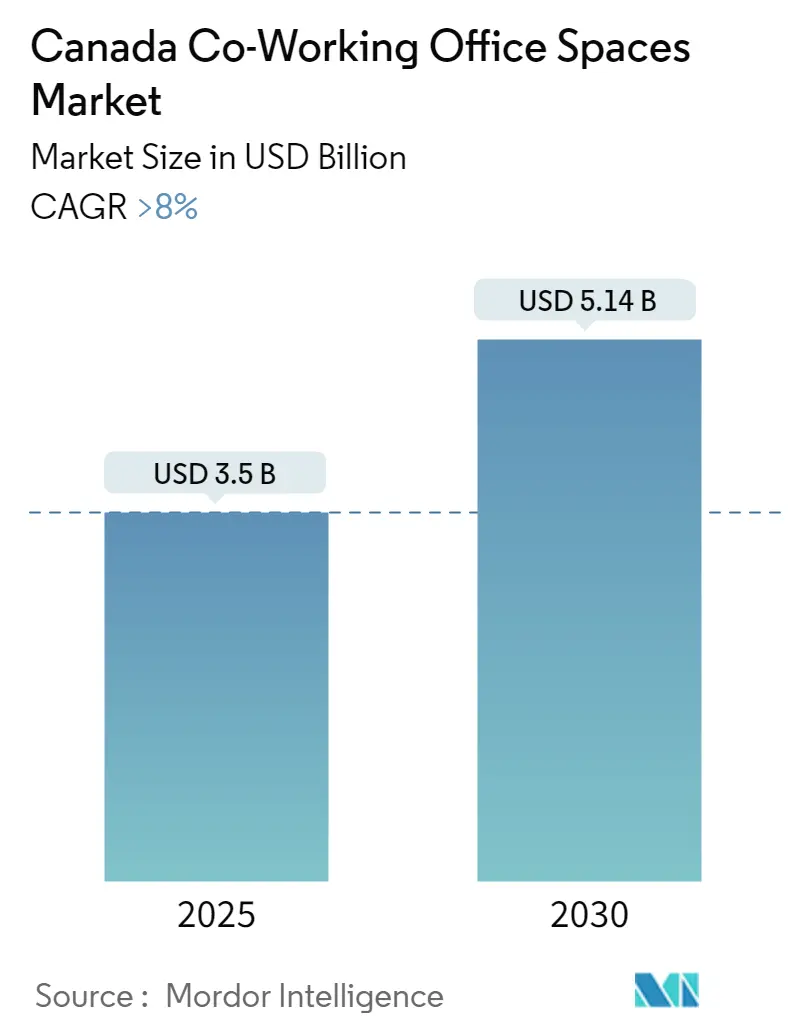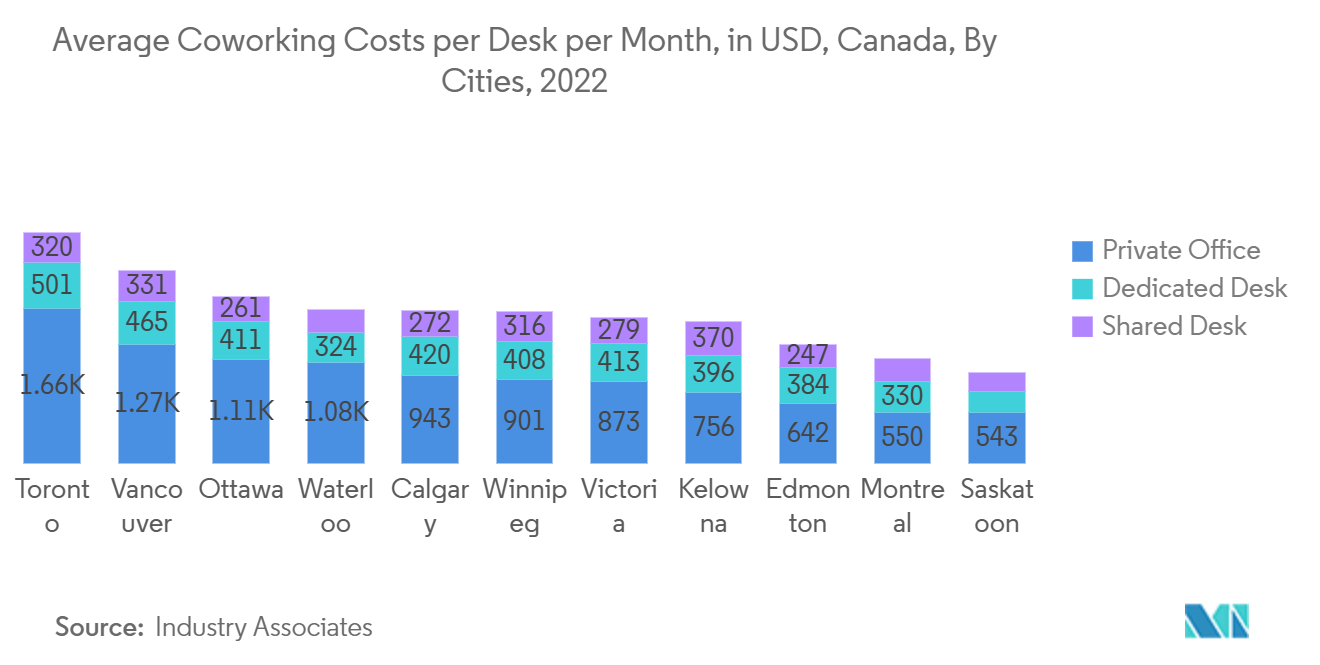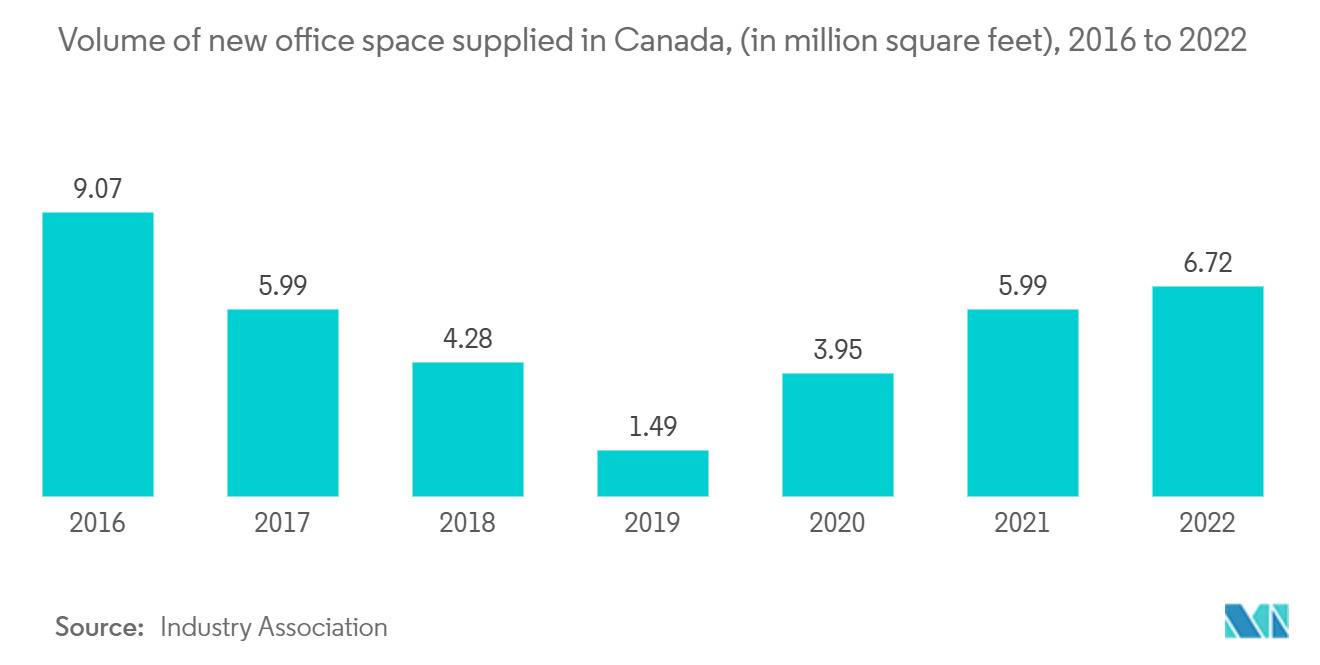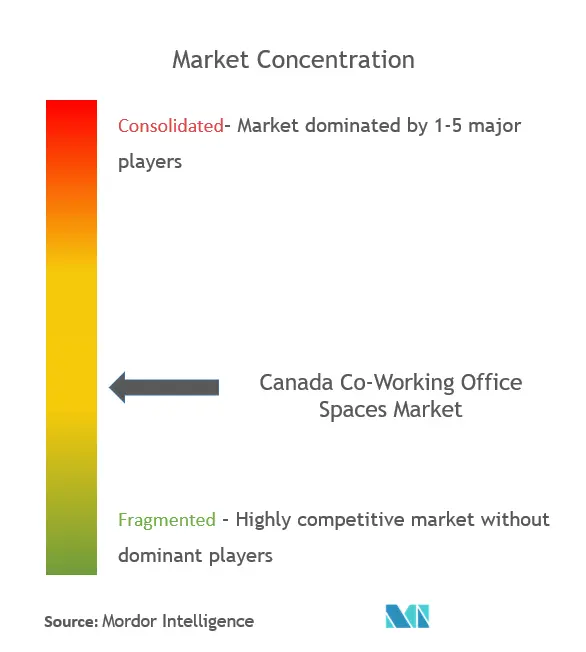
Canada Co-Working Office Spaces Market Analysis
The Canada Co-Working Office Spaces Market size is estimated at USD 3.50 billion in 2025, and is expected to reach USD 5.14 billion by 2030, at a CAGR of greater than 8% during the forecast period (2025-2030).
- In Canada, the COVID-19 pandemic impacted the co-working office space market. Due to the lockdown restrictions, the companies lost 75% of their customers. People are returning to co-working spaces more than a year and a half later. These changes are proving to be beneficial to co-working spaces, which were growing increasingly popular before the outbreak impacted their economic models. As COVID-19 cases decreased, people sought new ways to work, socialize, and get out after more than a year at home.
- The co-working trend has evolved into a transformative force in the Canadian corporate scene. New work patterns are in demand, and many flexible office operators are gaining a foothold in the lease market. Co-working real estate alternatives are reshaping other key markets in Canada. Since 2017, the flexible footprints of Calgary, Ottawa, and Vancouver have grown by more than 80%. The Waterloo region competed with Toronto (1.8%) in terms of market penetration of co-working space operations (with coworking accounting for 1.4% of total office supply). Suburban growth has outperformed downtown growth in Edmonton and the Waterloo region. The suburban co-working space market in Vancouver grew by 83%.
- According to Canadian press, there are currently 617 co-working spaces in Canada, including locations run by major corporations such as Staples. JPMorgan Chase asked all of its workers to return to work. In the meantime, Ottawa-based e-commerce company Shopify abandoned its headquarters in favor of a remote-only workforce. However, as vaccine protection improves and the debate over the future of work heats up, some businesses see an opportunity to strike a middle ground by adopting a more flexible approach to the workplace through co-working.
- Overall, the future of coworking looks bright. The demand for flexible workspace options, the use of technology and automation, the emphasis on sustainability and green initiatives, and the desire for community and collaboration will all be factors in its growth and development. As more people work remotely or as freelancers, coworking spaces will continue to provide a valuable solution to the need for flexible, affordable workspace options.
Canada Co-Working Office Spaces Market Trends
Toronto Region is Providing Ample of Opportunities to Tech Giants and Promoting the Market Growth
A report from the business world says that the IT industry was responsible for a big chunk of office leasing during the pandemic.Toronto leads the way in North America for tech job development. According to the survey, which assesses the influence of the IT industry on office demand and rents in Canada's 30 largest tech regions, Toronto saw a 26% increase in job growth from 2019 to 2020. Over the previous five years, high-tech companies have dominated the rental of office space.
Not surprisingly, the most expensive places were Toronto and Vancouver, where a private office costs an average of USD 1,657 and USD 1,270 per month.Other markets that averaged USD 1,000 or more per month for a private office included Ottawa and the Waterloo region, representing USD 1,112 and USD 1,083 respectively.
Co-working office spaces operated by real estate operators occupy 3.1 million square feet of office space, or 1.8% of the region's total office stock. The bulk of the space, 2.3 million square feet, is downtown, in 147 locations out of a total of 216 flexible workspaces across the GTA. Regus/Spaces is Toronto's largest flexible operator, with a 1.3 million sq. ft. footprint across 56 locations, or 42% of the market by square footage. It plans to add 347,000 sq. ft. over the next two years.
With a vacancy rate of 8%, Toronto has the highest downtown Class A rates, at CAD 34.18 (USD 25.53) per sq. ft. More than 7.5 million square feet of new supply are still under development in the city, with about 600,000 square feet under construction in the suburbs. However, during Q4 2021, more than 1.3 million sq. ft. of downtown office space was absorbed, slightly exceeding by roughly 40,500 sq. ft. the amount of newly completed supply added to the market over the same period. Owing to the above points, Toronto is expected to dominate the Canada co-working office space market during the forecast period.
Rising Supply of Co-working Office Space across Urban and Sub-urban regions
Hybrid and remote work arrangements will become the norm in 2022, which is why the world's largest flexible workspace and office provider continues to grow. The Canadian co-working office market is dominated by two major players, IWG and WeWork, which represent more than half of the national inventory. There are hundreds of single-site operators across the country, however, which make up over one-third of the market. IWG (Flexible Workspace and Office Provider) opened nine Canadian sites in 2022 and is focusing on expansion in secondary, tertiary, and suburban markets in which it had no, or minimal, presence.
In Canada, the amount of new office space rose for the second year in a row in 2022, and it was expected to keep going up in 2023.In 2021, there will be a total of almost six million square feet of new supply in the downtown and suburban office real estate markets.
Five new spaces totaling 173,500 sq. ft. will launch throughout Canada as demand for co-working spaces grows due to improved labor flexibility. About 83% of businesses are implementing a flexible or hybrid working strategy for their employees, allowing people to work differently than they did before the pandemic. Spaces recently opened a 26,000-sq.-ft. Zibi Ottawa cross-provincial facility. It is part of the 34-acre Zibi mixed-use complex on Chaudière Island, which connects Ottawa and Gatineau, and is housed in a refurbished four-story former paper mill building at 4 Booth St.
Canada Co-Working Office Spaces Industry Overview
The Canadian co-working office space market is fragmented with the presence of several privately owned co-working spaces. The market is expected to grow during the forecast period due to huge investments and funding received by companies in the industry. Some of the key players in the market include Lab T.O., District 28, La Halte 24/7, L Atelier Vancouver, BNKR, WeWork, and Regus. Major companies in the market have adopted new technology adoption, partnerships, business expansions, and acquisitions as their key developmental strategies to offer better services to customers in the industry. For instance, in June 2021, WeWork, one of the leading global flexible space providers, announced that WeWork on Demand, an app providing pay-as-you-go access to workspace and meeting rooms, is now available in Canada. WeWork On Demand is available in 12 buildings across Toronto, Vancouver, Calgary, and Burnaby.
Canada Co-Working Office Spaces Market Leaders
-
Lab T.O.
-
District 28
-
La Halte 24/7
-
L’ Atelier Vancouver
-
BNKR
- *Disclaimer: Major Players sorted in no particular order
Canada Co-Working Office Spaces Market News
- January 2023: Captivate, a leading digital out-of-home video network, announced its strategic partnership with WeWork, a leading global flexible space provider, to transform existing digital screens in WeWork lobbies, elevator banks, and communal workspaces to display the Captivate on-screen content experience. This partnership makes Captivate WeWork's exclusive ad sales representation for the U.S. and Canada.
- January 2022: In Vancouver, a new space in the Broadway Corridor, dubbed City Link, will bring 40,000 sq. ft. to Mount Pleasant, which IWG has found to be "Vancouver's fastest-growing tech hub". Meanwhile, the new King George Hub will offer even more space, with some 51,500 sq. ft. planned.
Canada Co-Working Office Spaces Industry Segmentation
Co-working spaces refer to working arrangements in which people from different teams and companies come together to work in a single shared space. A co-working space is characterized by shared facilities, services, and tools. Sharing infrastructure in this way helps spread the cost of running an office across members.
The Canada Co-working Office Space Market is segmented by end user (personal user, small-scale company, large-scale company, and other end users), by type (flexible managed office and serviced office), by application (information technology (IT) and information technology (ITES), legal services, BFSI (banking, financial services, and insurance), consulting, and other services), and by geography (Vancouver, Calgary, Ottawa, Toronto, and Rest of Canada). The report offers the market size and forecast in value (USD) for all the above segments.
| By End-User | Personal User |
| Small Scale Company | |
| Large Scale Company | |
| Other End-Users | |
| By Type | Flexible Managed Office |
| Serviced Office | |
| By Application | Information Technology (IT and ITES) |
| Legal Services | |
| BFSI (Banking, Financial Services, and Insurance) | |
| Consulting | |
| Other Services | |
| By Geography | Vancouver |
| Calgary | |
| Ottawa | |
| Toronto | |
| Rest of Canada |
Canada Co-Working Office Spaces Market Research FAQs
How big is the Canada Co-Working Office Spaces Market?
The Canada Co-Working Office Spaces Market size is expected to reach USD 3.50 billion in 2025 and grow at a CAGR of greater than 8% to reach USD 5.14 billion by 2030.
What is the current Canada Co-Working Office Spaces Market size?
In 2025, the Canada Co-Working Office Spaces Market size is expected to reach USD 3.50 billion.
Who are the key players in Canada Co-Working Office Spaces Market?
Lab T.O., District 28, La Halte 24/7, L’ Atelier Vancouver and BNKR are the major companies operating in the Canada Co-Working Office Spaces Market.
What years does this Canada Co-Working Office Spaces Market cover, and what was the market size in 2024?
In 2024, the Canada Co-Working Office Spaces Market size was estimated at USD 3.22 billion. The report covers the Canada Co-Working Office Spaces Market historical market size for years: 2019, 2020, 2021, 2022, 2023 and 2024. The report also forecasts the Canada Co-Working Office Spaces Market size for years: 2025, 2026, 2027, 2028, 2029 and 2030.
Our Best Selling Reports
Canada Co-Working Office Spaces Industry Report
Statistics for the 2025 Canada Co-Working Office Spaces market share, size and revenue growth rate, created by Mordor Intelligence™ Industry Reports. Canada Co-Working Office Spaces analysis includes a market forecast outlook for 2025 to 2030 and historical overview. Get a sample of this industry analysis as a free report PDF download.






